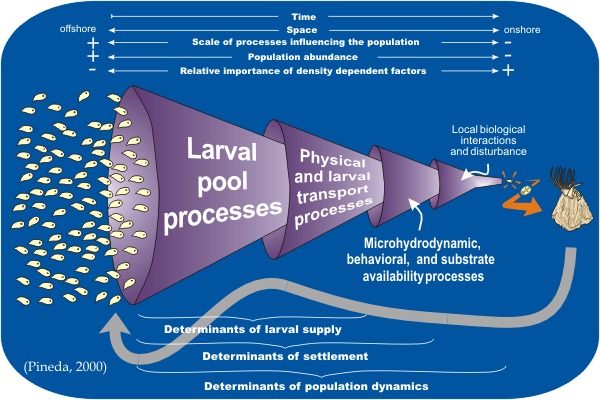|
|
|
Why study
larval transport, settlement, and recruitment? Why follow settlers all
the way to reproduction?
|
|
The number of young larvae transported to the adult
habitats could determine adult abundance of many benthic species. The
figure below shows a representation of how different processes influence
population size of adults. The larger the cone the more critical the
process because, for example, if there are no larvae
transported from offshore larval habitats to adult coastal habitats then
no reproductive individuals would be subject to mortality due to
competition, disturbance or predation.
|
|

Click here for a large format jpg
|
|
Hierarchy of settlement
processes
Settlement processes are hierarchical in more
than one axis. They are both serial, and ordered in space, starting with
processes in the larval pool, far from the settlement site, and ending
in processes occurring around the settlement site. There is also a scale
correspondence, with larger spatial scale processes occurring in the
larval pool, followed by physical transport processes, and smaller scale
processes occurring at the settlement site. Larger scale hydrodynamic
("oceanographic") factors tend to be more pervasive in the larval pool
and transport stages, with smaller-scale processes more pervasive during
transport (e.g. accumulation processes) or settlement (substrate
availability; micro-hydrodynamics). Finally, there is also an abundance
relationship, where processes in the larger scales operate over a larger
number of individuals than processes in the smaller scales.
Large-scale offshore oceanographic processes operate first over higher
abundances than the small-scale nearshore processes that operate last
over fewer individuals (Pineda,
1994, and 2000).
|
|
Studying larval transport, dispersal and
settlement may not be sufficient for understanding determination of
population growth
Knowledge of larval
transport and dispersal is important for understanding the temporal and
spatial dynamics of benthic populations. Nonetheless, if the motivation
to study larval transport, dispersal and settlement lies on
understanding determination of population growth, spread of
invasive species, and other phenomena that assume survival to
reproduction, understanding which individuals survive to settlement
is only part of the story because (a) in most species, the majority of
the settlers die before reproducing and (b) individuals settlers that
survive to reproduction are not a random sample of the settlers (see
Pineda et al, 2006). Thus, ultimately, studies should follow
individuals that disperse and settle all the way to reproduction (see
discussion in
Pineda, Hare and Sponaugle, 2007).
|
|
The importance of
recruitment in benthic populations
David et. al (1997) describe well why it is important to study larval
transport, settlement, and recruitment:
|
|
"Studies of marine invertebrates
have led to the emergence of new paradigms in population dynamics, which
differ sharply from classical models of population growth that apply,
for example, in terrestrial taxa. Indeed, recruitment, rather than
reproductive output, is the key concept for the demography of marine
species, and has been recognized as one of the main determinants of
spatial and temporal variations in population size. Most marine taxa
have complex life cycles with planktonic larvae that settle and
metamorphose into sessile benthic adults (Barnes 1986). In this case,
populations must be considered as open systems (Roughgarden et al. 1985;
Bence and Nisbet 1989), in that settling larvae may come from remote
places. For this reason, recruitment is a critical factor, and is not
necessarily correlated with the local reproductive output. Understanding
the determinants of recruitment is therefore one of the major goals in
marine population dynamics."
Quoted from David, P., P. Berthou, P. Noel and P. Jarne 1997. Patchy
recruitment patterns in marine invertebrates: a spatial test of the
density-dependent hypothesis in the bivalve
Spisula ovalis. Oecologia (Berl.). 111, 331-340
|
|
|
|
Click for a 300 Kb
animation of a setting Chthamalus larva
|
|
|
|
|
|
| |
|
|

